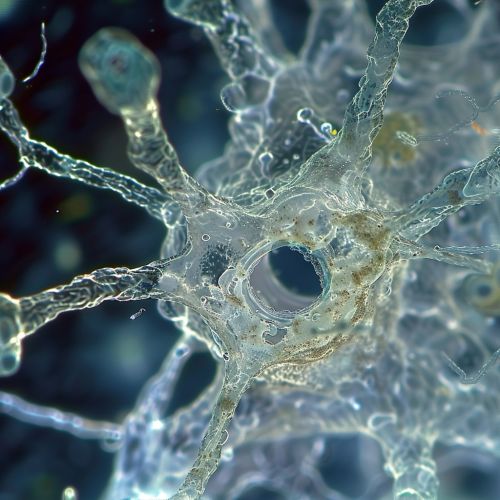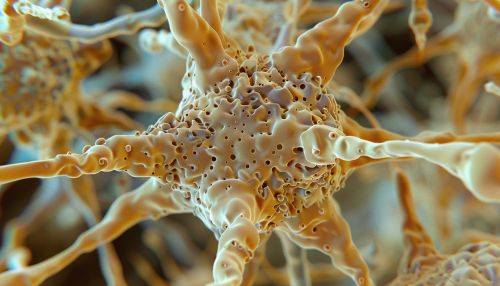Astrocyte
Overview
Astrocytes, also known as astroglia, are a type of glial cell that are star-shaped and are the most abundant cell within the human brain. They perform many functions, including biochemical support of endothelial cells that form the blood-brain barrier, provision of nutrients to the nervous tissue, maintenance of extracellular ion balance, and a role in the repair and scarring process of the brain and spinal cord following traumatic injuries.


Function
Astrocytes play a crucial role in the brain's functionality. They are involved in several neurological processes, including the maintenance of the blood-brain barrier, regulation of blood flow, nutrient supply, ion homeostasis, and neurotransmitter uptake and release.
Blood-Brain Barrier
Astrocytes are essential in the formation and maintenance of the blood-brain barrier. This barrier is a protective mechanism that prevents potentially harmful substances in the bloodstream from entering the brain. Astrocytes achieve this by forming a tight seal around the blood vessels in the brain, allowing only certain substances to pass through.
Regulation of Blood Flow
Astrocytes also play a role in the regulation of cerebral blood flow. They can sense changes in neuronal activity and respond by altering the diameter of blood vessels, thereby controlling the amount of blood that reaches different areas of the brain.
Nutrient Supply
Astrocytes supply neurons with essential nutrients such as glucose and lactate. They also play a role in the metabolism of neurotransmitters, which are chemicals that transmit signals between neurons.
Ion Homeostasis
Astrocytes help to maintain the balance of ions in the extracellular space, which is crucial for the proper functioning of neurons. They can absorb excess potassium ions from the extracellular space and release them back when needed.
Neurotransmitter Uptake and Release
Astrocytes can take up neurotransmitters from the synaptic cleft, the space between neurons where neurotransmitters are released. This process helps to terminate the action of neurotransmitters and prevent their accumulation in the synaptic cleft. Astrocytes can also release neurotransmitters, contributing to neuronal communication.
Development
Astrocytes originate from the neural stem cells in the brain. The process of their development, known as astrogenesis, occurs mainly during the late stages of embryonic development and continues after birth. Astrocytes continue to be produced throughout life, but at a slower rate compared to other types of cells in the brain.
Classification
Astrocytes can be classified into several types based on their location and function. The two main types are protoplasmic astrocytes, which are found in the grey matter of the brain, and fibrous astrocytes, which are located in the white matter. Protoplasmic astrocytes have many branching processes that make contact with neurons and blood vessels, while fibrous astrocytes have fewer processes and are in close contact with the nodes of Ranvier, the gaps in the myelin sheath of neurons.
Role in Disease
Astrocytes have been implicated in several neurological disorders, including Alzheimer's disease, Parkinson's disease, amyotrophic lateral sclerosis, and multiple sclerosis. In these diseases, astrocytes may undergo reactive astrogliosis, a process in which they become hypertrophic and proliferative. This can lead to the formation of a glial scar, which can inhibit neuronal regeneration and contribute to the progression of the disease.
Research and Future Directions
Research on astrocytes is ongoing, with many studies focusing on their role in neurological disorders. Understanding the functions of astrocytes and their involvement in disease could lead to the development of new therapeutic strategies for treating neurological disorders.
